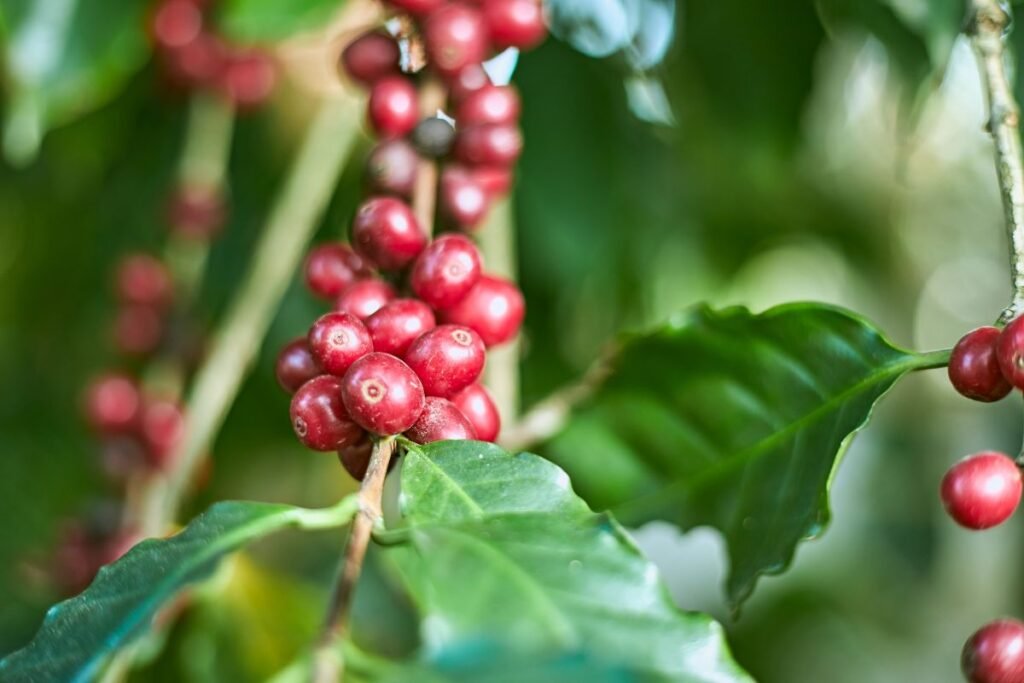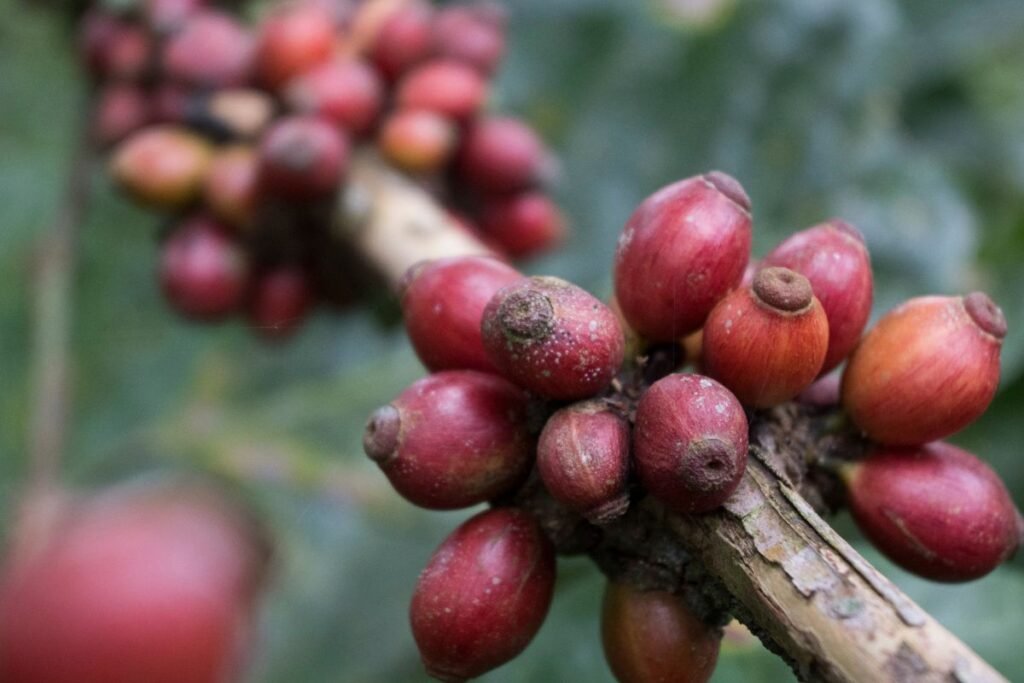While there are 124 species of coffee, there are three main types of coffee beans grown around the world: Arabica, Robusta and Liberica. Each type has a distinct aroma, flavour profile and strength, making them suitable for different brewing methods and personal preferences.
Before we get started, it’s important to note that coffee type refers to the botanical variety of the bean. This is different to the beans’ origins, which focuses on the geographic region where the beans are grown. The beans’ unique flavour is shaped by the local environment, including the soil, climate, and altitude, but its fundamental flavour characteristics and caffeine content are determined by its type — the botanical classification of the coffee plant that this blog explains.
1. Arabica (Coffea Arabica)
Arabica beans are the most popular coffee beans in the world, accounting for about 60% of the world’s coffee production. Originating from the southwestern highlands of Ethiopia (Kaffa), Arabica beans are known for their smooth, sweet flavours, often containing hints of berries, caramel, chocolate, and other floral notes.
Thanks to its natural sweetness (Arabica contains almost twice the concentration of sugar and about 60% more lipids than Robusta beans) and delicate finish, it is often considered the nicest-tasting coffee for consumers.
Growing Conditions
Arabica coffee plants thrive at higher altitudes, between 950 to 2,000 meters above sea level, with steady rainfall. The plant can tolerate low temperatures, but not frost or strong winds, and it does best with an average temperature between 15 and 24°C. The Arabica coffee plant takes three to four years to produce fruit, referred to as coffee cherries. Because the trees are often less than 6 feet tall, this makes the pruning and harvesting process significantly easier than taller plants.

The downside is that the Arabica plant is more prone to diseases, which can cause challenges when it comes to farming the bean, leading to a higher average price per kilogram compared to other coffee types.
If you enjoy a coffee with balanced acidity and a delicate aroma, Arabica will be your go-to bean.
Recommended Brewing Methods
One of Arabica’s selling points is that it works with various brewing methods, from filter and French press to espresso and drip coffee. However, the pour-over method, such as the V60 or Chemex, is ideal for highlighting the complex flavours of Arabica beans. It allows for precise control over water temperature and extraction time, ensuring that the nuanced notes of the beans are fully developed in your cup.
When it is served cold or blended with milk or cream, on the other hand, it can lose some of its flavour. However, this won’t be noticeable for the casual coffee drinker.
2. Robusta (Coffea Canephora)
Robusta beans are the second most common type of coffee bean, making up around 40% of global coffee production. Robusta originates in central and western sub-Saharan Africa, but the world’s largest producers are Vietnam, Brazil, Indonesia and Uganda. As its name suggests, its a more robust bean than Arabica.
Compared to Arabica beans, Robusta beans have a stronger, more bitter flavour, as well as a higher caffeine content (2.7% caffeine content, compared to Arabica’s 1.5%). As a result, Robusta is most suitable for instant coffee granules and powders. The bean not only has a stronger taste but a stronger and harsher smell too.
Growing Conditions
Unlike Arabica plants, the Coffea canephora plant grows at lower altitudes (0 to 800 meters), in warmer climates and higher temperatures, and is more resistant to disease, rot and fruit-ruining pests due to caffeine acting as a natural insect repellent. The coffee caniphora species can also be grown in any number of altitudes and climates.

Recommended Brewing Methods
Robusta beans are ideal for when you want a strong, full-bodied shot that can cut through milk, steam or other ingredients and flavourings. The concentrated brewing process of espresso machines, in particular, brings out the intense flavours and thick crema that Robusta beans are known for. The high pressure forces hot water through the finely ground coffee, creating a rich, bold cup with a velvety texture.
If you like a bold, strong coffee with a kick, Robusta beans are a great choice.
3. Liberica (Coffea Liberica)
Liberica beans are a unique and rare type of coffee that has been around since the late 1800s. It is native to Western and Central Africa but is often grown in specific regions, such as the Phillippines, Malaysia and some parts of Africa. Liberica beans make up a small percentage of global coffee production (1.5%), and are most often mixed with Arabica or Robusta beans, rather than sold on their own.
Coffee Liberica beans are larger than Arabica and Robusta beans and are known for their distinctive (and often polarizing) taste and aroma. The beans have a smokier, fruitier and floral taste that is often described as being similar to jackfruit.
The caffeine concentration of Liberia beans is the lowest of the three cultivars, with only 1.23g (0.04oz) of caffeine for every 100g (3.52oz) of beans.
Growing Conditions
Liberica trees are large and can grow up to 20 metres (60 feet) high. The size of the cherries, the beans, and the leaves of barako are also among the largest of all coffee varieties. Indeed, the shape of the bean itself is unique too, with an asymmetric shape and characteristic “hook” at the tip.
Liberica is a relatively low-yielding crop compared to other coffee species, and due to the plant’s height and need to be grown in highly specific conditions, it can be difficult to harvest and process. This is one of the reasons it is so rare and at risk of possible extinction.

Recommended Brewing Methods
Liberica beans are often used in traditional brewing methods. However, the French press is an excellent method as it allows the coffee to steep longer, extracting the bold and unusual flavours for a strong, aromatic cup. Alternatively, cold brewing allows the natural sweetness and fruitiness of the beans to shine through without the bitterness that can sometimes accompany hot brewing methods.
Excelsa (Coffea Excelsa)
Excelsa beans were known as a separate coffee species, but in recent years, have been identified as a variety of the Liberica species. Excelsa beans have a tart, fruity, and sometimes wine-like flavour, which adds depth and brightness to coffee blends. It is known for showing attributes of both light and dark roast coffees that create a unique profile, making it frequently sought out by coffee enthusiasts.
The International Coffee Organization (ICO) does not have official stats on Excelsa coffee beans because they do not consider the demand for them or Liberica coffee beans to be commercially significant.
What About Coffee Blends?
While single-origin coffees allow you to explore the distinct flavours of a particular region or bean type, coffee blends offer a symphony of flavours. This is known as a blend because it is created by mixing different types of coffee beans, often from different origins or species, to create a unique flavour profile. Arabica-Robusta is the most common type of blend, combining the smooth and familiar flavours of Arabica beans with the bolder taste and higher caffeine content of Robusta.

Which Coffee Beans Should I Choose?
Choosing the right coffee beans depends on your taste preferences, desired caffeine content, and preferred brewing method. While Arabica is the most popular choice, for a stronger or more unique taste, you might wish to get Robusta or Liberica beans. Indeed, Robusta beans have nearly double the caffeine content of Arabica beans, but Arabica still has more caffeine than Liberica beans, so you should consider how much caffeine you would like.
Keep in mind that blending different types of beans can create a balanced and unique flavour profile! You could experiment with mixing Arabica and Robusta for a well-rounded cup, or add Liberica or Excelsa for a more nuanced flavour.
Need a recap? This table summarizes the characteristics of each coffee type, including their flavour profiles, growing conditions, and caffeine content.
| Coffee Type | Flavour Profile | Growing Conditions | Caffeine Content |
|---|---|---|---|
| Arabica (Coffea Arabica) | Mild, smooth and aromatic with fruity, floral, and nutty notes, such as berries, caramel, chocolate, and floral notes. Low acidity and a light aroma. | Grows best in higher altitudes (600–2,000 meters), requires moderate temperatures (15–24°C), and steady rainfall. | 1.2% – 1.5%. |
| Robusta (Coffea Canephora) | Strong, harsh, and bitter with a grainy or nutty aftertaste. Full-bodied taste. | Can grow at lower altitudes (200–800 meters), more resilient, tolerates higher temperatures (24–30°C), and less water. | 2.2% – 2.7%. |
| Liberica (Coffea Liberica) | Unique flavour with a jackfruit-like flavour. Full-bodied with fruity or floral undertones, | Thrives in low-altitude areas (0–800 meters), high humidity, warm temperatures (20–30°C), and requires ample rainfall. | 1.23% caffeine content, the lowest among the three types. |
| Excelsa (Coffea Excelsa) | Tart and fruity with a complex flavour profile, combining both light and dark roast characteristics. Wine-like and acidic. | Similar growing conditions to Liberia; large trees and specific environmental requirements. | The same average caffeine content as Liberica. |
Check out our coffee blog page for more coffee insights and tips from our experts. And if you have any questions about our products or coffee trailer events, please don’t hesitate to get in touch here or using the form below. Did you know that we also offer coffee in wholesale quantities for cafes, hotels, delis, camping/glamping sites, catering trailers and other businesses?


